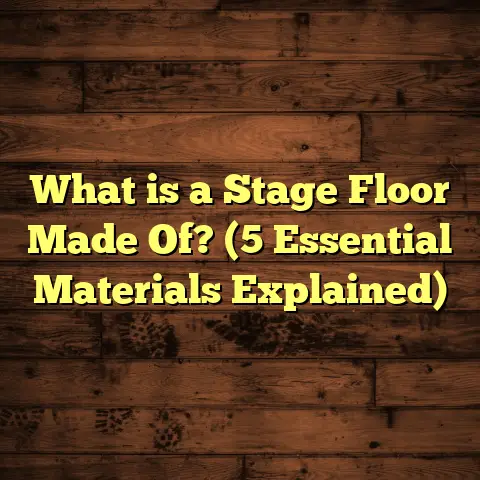What is Tile Flooring? (5 Key Benefits for Your Home Decor)
When I first started helping friends and clients with home renovations, I quickly realized just how much impact flooring has on the entire look and feel of a space. Let me tell you, choosing the right floor is not just about picking something pretty. It’s about durability, comfort, style, and long-term value. I remember one time working on a kitchen renovation for a family with two energetic kids and a big Labrador. They wanted something that looked good but would last through all the spills, paw prints, and daily chaos.
We went with tile flooring. The transformation was incredible. Not just because it looked amazing but also because it was practical and easy to clean. That experience was one of many that made me appreciate tile flooring as a go-to choice for many homeowners. Over the years, I’ve installed dozens of tile floors and learned a lot about why this material keeps being the favorite for kitchens, bathrooms, and even living rooms.
If you’re wondering whether tile flooring might be right for your home, stick around. I’ll explain what tile flooring is, and why it offers so many advantages for home decor and everyday life.
What is Tile Flooring?
Tile flooring is a type of floor covering made up of individual pieces called tiles. These tiles are usually made from ceramic, porcelain, or natural stone materials such as marble, granite, or slate. Other types include glass and cement tiles, but ceramic and porcelain dominate the market.
Each tile is a flat piece that’s laid side by side on a floor surface to create a continuous layer. Tiles come in all sorts of shapes—squares are most common, but rectangles, hexagons, and mosaics are popular too.
The installation process involves adhering tiles to the subfloor using a strong mortar or adhesive. Once the tiles are set in place, installers fill the gaps between tiles with grout—a mix that hardens and seals the joints. After drying, grout can be sealed to protect against stains and moisture.
The appeal of tile flooring lies in its versatility. You can find tiles in nearly every color imaginable—from stark white to deep navy blues, bright reds to earthy browns. Textures range from smooth and glossy to rough and matte finishes. This broad range allows homeowners to customize their floors to match any style—whether you love classic looks or want something modern and bold.
A Bit of History
Tile flooring isn’t new by any stretch. People have been using tiles for thousands of years—ancient civilizations like the Romans and Persians created beautiful mosaic floors with tiny pieces of colored stone or glass. Fast forward to today, technological advances mean tile is more durable, affordable, and easier to install than ever before.
1. Durability That Keeps Up With Life
One reason I always recommend tile flooring is how incredibly tough it is. I’ve seen tile floors withstand everything from heavy furniture to muddy boots without a scratch.
Unlike hardwood or carpet, tiles won’t dent or gouge under pressure. They’re also resistant to moisture and stains—a major advantage in kitchens and bathrooms where spills happen regularly.
Scientific Facts About Tile Durability
Let me share some numbers that back this up: porcelain tile scores around 7 on the Mohs hardness scale (which measures mineral hardness). Quartz is also 7, which means porcelain tiles are nearly as hard as quartz—the second hardest mineral after diamond (which scores 10). This explains why porcelain resists scratches so well.
Ceramic tiles are softer but still offer good durability. Their water absorption rate varies but generally ranges from about 0.5% to 7%, depending on quality and firing temperature. Lower absorption means less water soaks into the tile—reducing damage risk from moisture.
According to data from the Tile Council of North America (TCNA), porcelain tiles have water absorption rates below 0.5%, making them highly waterproof compared to ceramic or natural stone.
Real-Life Examples
I once worked on renovating an old farmhouse kitchen where the original wood floors were rotting from years of water spills near the sink. We replaced everything with porcelain tile in a warm wood-look finish. The homeowners were thrilled with how well it held up after two years of daily cooking chaos—no warping or stains.
Another client who runs a small daycare center installed ceramic tile throughout the playroom and entry area. The tiles resisted scratches from toys and high foot traffic while being easy to mop up after snack time messes.
Longevity
Tile floors can last decades with proper care—25 to 50 years is common. That’s longer than most hardwood floors (typically 20-30 years) or carpets (10-15 years). This durability makes tile flooring an excellent investment.
2. Easy Maintenance and Cleaning
If you want my honest opinion, tile floors are some of the easiest floors to maintain in a busy household.
I know firsthand how frustrating carpet stains can be or how wood floors get scratched by pets’ nails or spilled drinks. Tile floors? You just sweep or vacuum regularly—and mop occasionally.
The Cleaning Routine
For everyday cleaning, all you really need is a broom or vacuum followed by a damp mop with warm water and mild detergent (pH-neutral cleaners work best). There’s no need for special polishes or waxes like you’d use on hardwood.
Grout lines between tiles require some attention—they can collect dirt or discolor over time if not sealed properly. But sealing grout every few years drastically reduces this problem.
Why It’s Perfect for Families or Pet Owners
I helped a family with three young kids who were constantly dropping food or spilling drinks in their kitchen. They wanted a floor that wouldn’t stain or smell after accidents. Tile was perfect.
Another time, a dog owner told me their tiled entryway was a lifesaver during rainy months—muddy paw prints wiped off easily without leaving marks.
Cost-Effective Cleaning
When you add up the costs of carpet shampoos, wood floor refinishing, or replacing damaged floors over time, tile’s low maintenance saves money long term.
According to industry estimates, homeowners spend 30-40% less annually on cleaning supplies and maintenance for tile floors versus carpeted areas of similar size.
3. Variety in Style and Design
One of my favorite things about tile flooring is how many design possibilities there are.
When I talk with clients about their style preferences, they’re often amazed by how tiles can look like almost anything—wood grain, marble veining, concrete texture—you name it.
Tile Types and Their Aesthetic Appeal
- Ceramic Tiles: Available in countless colors and patterns; often glazed for shiny finishes.
- Porcelain Tiles: Denser than ceramic; great for mimicking natural materials like stone or wood.
- Natural Stone Tiles: Marble, granite, slate; unique patterns but require sealing.
- Glass Tiles: Mostly used as accents; reflective surfaces add brightness.
- Mosaic Tiles: Tiny pieces forming intricate patterns; perfect for backsplashes or feature walls.
Trends I’ve Seen Growing
In recent years, large-format tiles (24×24 inches and bigger) have become popular because fewer grout lines create a seamless look.
Patterned encaustic-style tiles bring vintage charm to kitchens or bathrooms—these have geometric designs in bold colors.
Wood-look porcelain tiles continue to rise in popularity because they combine warmth with durability—great for homes where hardwood isn’t practical.
Personal Stories
One client wanted a Mediterranean feel for her bathroom. Together we chose terracotta-style tiles paired with hand-painted mosaic accents around the vanity. The result was stunning—she called her bathroom “my little vacation spot.”
Another homeowner was hesitant about using tile in his living room but loved the idea of wood-look porcelain that felt warm underfoot yet resisted pet scratches better than real wood.
Industry Insights
According to Houzz’s 2023 report on kitchen remodeling trends:
- 65% of homeowners preferred tile flooring due to design variety.
- Over 40% chose large-format tiles for a modern aesthetic.
- Natural stone remains popular among high-end renovations despite higher costs.
4. Heat-Friendly Flooring for Comfort
Here’s something many people overlook: tile works great with radiant heating systems beneath your floor.
When I installed heated tile floors in a client’s bathroom last winter, they told me it completely changed their morning routine—no more stepping onto cold floors!
How It Works
Tile has high thermal conductivity compared to carpet or wood, meaning it transfers heat quickly and evenly across its surface. This makes radiant heat efficient when paired with tile because heat rises gently from below instead of getting trapped in insulating materials like carpet fibers.
Energy Savings
Studies from the U.S. Department of Energy suggest radiant heating combined with tile flooring can reduce energy use for heating by around 10-15%. That translates into noticeable savings on your utility bills over time.
Comfort Factor
Besides energy efficiency, heated tile floors add comfort especially during cold weather months. Think about how nice it feels walking barefoot on warm tiles after getting out of bed or shower.
Installation Notes
If you’re considering heated floors:
- Choose porcelain or ceramic tiles—they handle temperature changes well.
- Ensure proper insulation below the heating system to avoid heat loss.
- Professional installation is highly recommended for safety and performance.
5. Increases Home Value and Appeal
From all angles—durability, style, maintenance—tile flooring tends to boost home value when done well.
Real estate agents often highlight tiled kitchens and bathrooms as major selling points during showings because buyers appreciate their longevity and look.
Case Study: Zillow Research
A Zillow study found homes with professionally installed tile floors sold about 6% faster than those without upgraded flooring options.
Buyers see tile as a premium upgrade that reduces future repair costs—a big plus when making purchase decisions.
Return on Investment (ROI)
According to Remodeling Magazine’s annual Cost vs Value Report:
- Tile flooring remodels recoup about 70-80% of their cost at resale.
- High-end natural stone tile projects can fetch even better returns in luxury markets.
- Well-maintained tile floors keep homes looking fresh which helps maintain property value over time.
Personal Experience
I’ve seen multiple clients who renovated their kitchens with tile flooring later sell their homes at prices above neighborhood averages—many crediting the upgraded floor as one reason buyers were willing to pay more quickly.
More About Installation: What You Should Know
Since I’ve installed so many tile floors myself, I want to share some insider tips that can save headaches if you’re planning your own project:
Preparing Your Subfloor
Tiles need a flat, strong base free from cracks or movement because even slight shifts cause cracking over time.
Before installing tile:
- Remove old flooring completely.
- Repair cracks or uneven spots.
- Use cement backer board if installing over plywood surfaces.
Choosing Grout Color Wisely
Grout affects aesthetics more than most people realize:
- Dark grout hides dirt better but gives a stronger contrast.
- Light grout looks cleaner but requires more upkeep.
- Colored grout can add personality but may limit future design changes.
Sealing Natural Stone Tiles
Natural stones like marble or slate are porous so they absorb moisture easily:
- Seal stone tiles before grouting.
- Reseal every year or two depending on wear.
Ordering Extra Tiles For Waste
Cutting tiles to fit edges or around obstacles creates waste:
- Always order 10-15% more than your actual floor area.
- This covers breakage during cutting and future repairs.
Why Hiring Professionals Matters
While DIY installation might seem tempting for cost savings:
- Improper adhesive use leads to loose tiles.
- Incorrect grout application causes cracking.
- Uneven surfaces shorten floor lifespan.
Professional installers bring experience plus tools that ensure a flawless finish lasting decades.
Can Tile Flooring Be Used Throughout Your Home?
You might wonder if tile floors suit every room in your house?
While kitchens and bathrooms are classic spots for tile because of moisture resistance, you can absolutely use tile elsewhere:
- Entryways: Durable against dirt and weather exposure.
- Living rooms: Large-format wood-look porcelain adds warmth without scratching risks.
- Basements: Resists dampness better than wood.
- Laundry rooms: Handles water spills easily.
For bedrooms or cozy spaces where you want softness underfoot, combining tile with area rugs works well.
Common Questions I Hear About Tile Flooring
Q: Is tile cold underfoot?
A: Yes, it feels cooler than carpet or wood naturally but using radiant heating solves this perfectly for comfort year-round.
Q: Will tiles crack?
A: If installed correctly over a stable subfloor with proper materials, cracking is rare. Heavy impacts can cause damage but porcelain is very tough.
Q: How long does installation take?
A: Small rooms might take 2-3 days including drying times; larger areas can take a week or more depending on complexity.
Q: Can I install tile myself?
A: Possible if experienced in home improvement but mistakes are costly. Professional installation guarantees best results especially for large or complicated layouts.
Final Thoughts From My Work Experience
After years installing dozens of different floor types, I’m still impressed by what tile offers homeowners:
- It’s strong enough for busy families
- Easy enough for anyone to keep clean
- Stylish enough to match any decor
- Comfortable when paired with heating systems
- Valuable enough to boost resale potential
If you’re weighing options for your next project, tile deserves serious thought—not just for looks but how well it fits your lifestyle over time.
Have you tried living with tile floors? I’d love to hear your stories or questions—feel free to ask anytime!





